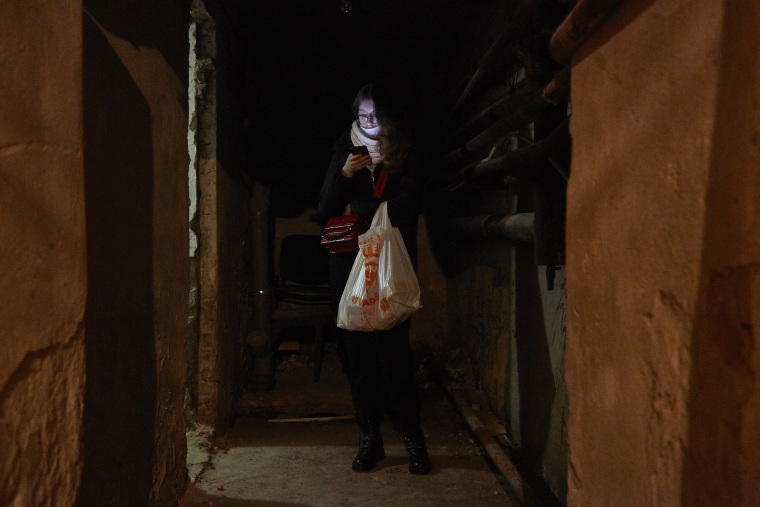Russia’s invasion of Ukraine has already fueled some nascent misinformation tactics, including the spread of realistic video game footage and the use of TikTok to create fake war zone livestreams.
The content highlights how misinformation on the internet tends to constantly evolve, with some older forms of misleading content remaining relevant (many users continue to share older videos mislabeled as coming from the ongoing conflict).
And while TikTok has in recent years vowed to crack down on misinformation, its relatively recent entry into the mainstream as a major social media platform, along with some of its unique features, have made it ripe for misleading content.
“The platform is flooded with raw footage, which is good and bad. For some people, they genuinely feel like they’re getting a more authentic experience that’s not through the filter of a news agency,” said Abbie Richards, a TikTok researcher at the nonprofit Accelerationism Research Consortium, which studies online terror movements. “At the same time, there’s just no verification.”
The war had already taken center stage on TikTok in recent weeks, where legitimate videos from Ukrainians showed Russian forces advancing toward the border over a week before Russia attacked.
And in recent days, viral misinformation has also spread on the platform. Among the more unique forms of misinformation are livestreams that have attempted to mimic some of the scenes in Ukraine, with users pointing cameras at nondescript scenes or looping video and playing sirens in the background.
In one livestream on Thursday, a TikTok user aimed the camera at the residential street outside a window and dubbed the sound of air-raid sirens over the footage. Days earlier, the same TikTok user showed a different angle of the same street, and the car license plates matched those in the U.K.
Thanks to TikTok’s donation system, which is widely used during livestreams as a way for users to tip creators, those streams can provide immediate financial incentives, though it was unclear how much money any particular stream brought in.
A TikTok spokesperson said that it is taking action against users who are pretending to livestream from Ukraine in order to solicit donations.
“We continue to closely monitor the situation, with increased resources to respond to emerging trends and remove violative content, including harmful misinformation and promotion of violence,” a TikTok spokesperson said.
Some TikTok users have already caught on. In the comment sections of livestreams containing misinformation, TikTok users are leaving comments like “Don’t donate,” and “Please report, it’s a scam.”
One TikTok user posted videos urging their 65,000 followers to watch their ongoing Ukraine livestream. In the livestream, the user thanked viewers who were sending donations while an air-raid siren blared in the background. Scrolling back on that same user’s account, videos showed them handling Moldovan currency, leading to comments calling the livestream a “scam.”
Only a few hundred viewers were watching the Moldovan user’s livestream, but another livestream with over 130,000 viewers appeared to be playing grainy footage from inside a crowded Ukraine subway station on a loop.
Other fake videos on TikTok are not livestreamed, but rather regular short-form videos that are taking advantage of the app’s audio features, which allows users to dub their content with sounds in the platform’s user-generated audio library.
The sounds of screaming, gunfights and air-raid sirens were uploaded to TikTok as an original sound bite by one user and was then used on more than 240 videos purporting to be from Ukraine.
Scenes from video games presented as real are a relatively new and increasingly popular form of misinformation on TikTok and Twitter, one that has gained steam as games become more realistic.
Footage from the flight simulator “Digital Combat Simulator World” was shared by Ukraine’s official Ministry of Defense on Twitter, and received over 600,000 views. The footage was previously uploaded as part of a highlight compilation on YouTube. Users on Facebook, Twitter and TikTok have repeatedly shared footage of the video game “Arma 3” as war footage from the Ukrainian invasion.
Clips of video game footage and of users rummaging through their own apartments are usually spliced with more dramatic audio from real atrocities.
The ease of use for this feature, which was initially used to lip sync to music and was pivotal to the growth of TikTok, is now being used to add more realistic sounds of war to computer-generated or otherwise banal videos.
Richards, the TikTok researcher, identified an otherwise harmless video of a man running away on his porch that had audio from a 2020 chemical explosion in Beirut dubbed over it. The video, uploaded on Thursday, had 6 million views in 12 hours.
Richards said the ease with which these videos can be created is an issue.
“I think that their infrastructure — the literal design of the platform — is part of the problem. It is amplifying fear and misinformation,” Richards said. “TikTok’s infrastructure is structurally incompatible with the moment.”
Still other videos are far more common forms of misinformation. On Thursday, shortly after Russia began its attack on Ukraine, a TikTok user posted a video of a soldier parachuting out of an airplane. The video was first posted in 2016 by an Instagram account with the same username.
